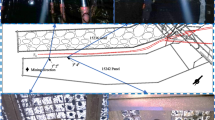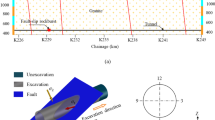Abstract
As the main battlefield of China’s transportation infrastructure gradually extends westward, more and more superlong deep-buried tunnels are being built in an environment where the neotectonic movements are extremely active. However, the faults formed by tectonic movements have an important disturbing effect on the distribution of geo-stress fields, but these effects have never been studied systematically. Thus, in this paper, based on the Anderson model and the Coulomb friction criterion, the disturbance influence of different factors was analyzed. These factors included the time effect, activity rate, friction coefficient, thickness, and dip angle. Meanwhile, a composite viscoelastic-plastic damage constitutive model was established to determine the evolution of damage in the fracture zone. According to the geo-stress inversion, the effect of faults on the geo-stress distribution was verified. The results showed that all types of faults exhibit geo-stress drop within the fault-affected area, among which the strike-slip fault is the maximum. With the increase of time and the fault activity rate, the geo-stress will increase slowly and continuously. In addition, with the increase of the thickness and dip angle of the fault, the geo-stress inside the fault tends to be flat. When approaching the fault plane, the σ1 orientation of reverse and normal faults is deflected towards the normal direction of the fault plane. Moreover, the σ1 deflection direction of the strike-slip fault is opposite its activity direction. The damage degree and range of the reverse fault are the most significant, and those of the strike-slip fault are the weakest.























Similar content being viewed by others
Data availability
All data, models, or code that support the findings of this study are available from the corresponding author upon reasonable request.
References
Álvarez-Fernández MI, González-Nicieza C, Argüelles A, Álvarez-Vigil AE (2011) Determination of the stress state in a rock mass subjected to excavation. Bull Eng Geol Environ 70:243–253
Aygar EB, Gokceoglu C (2021) A special support design for a large-span tunnel crossing an active fault (F9 tunnel, Ankara-Sivas high-speed railway project, Turkey). Environ Earth Sci 80:37
Barla G, Bonini M, Semeraro M (2011) Analysis of the behaviour of a yield-control support system in squeezing rock. Tunn Undergr Space Technol 26:146–154
Baziar MH, Nabizadeh A, Lee CJ, Hung WY (2014) Centrifuge modeling of interaction between reverse faulting and tunnel. Soil Dyn Earthq Eng 65:151–164
Baziar MH, Nabizadeh A, Mehrabi R et al (2016) Evaluation of underground tunnel response to reverse fault rupture using numerical approach. Soil Dyn Earthq Eng 83:1–17
Brown ET, Hoek E (1978) Trends in relationships between measured in-situ stresses and depth. Int J Rock Mech Min Sci Geomech Abstr 15(4):211–215
Cai QP, Peng JM, Ng CWW et al (2019) Centrifuge and numerical modelling of tunnel intersected by normal fault rupture in sand. Comput Geotech 111:137–146
Cao CY, Shi CH, Lei MF, Yang WC, Liu JW (2018) Squeezing failure of tunnels: a case study. Tunn Undergr Space Technol 77:188–203
Chen SD, Tang DZ, Tao S et al (2017a) In-situ stress measurements and stress distribution characteristics of coal reservoirs in major coalfields in China: implication for coalbed methane (CBM) development. Int J Coal Geol 182:66–84
Chen ZQ, He C, Wang J, Ma CC (2021) Time-dependent squeezing deformation mechanism of tunnels in layered soft-rock stratum under high geo-stress. J Mt Sci 18(5):1371–1390
Chen ZQ, He C, Wu D et al (2017b) Fracture evolution and energy mechanism of deep-buried carbonaceous slate. Acta Geotech 12:1243–1260
Chen ZQ, He C, Xu GW, Ma GY, Wu D (2019a) A case study on the asymmetric deformation characteristics and mechanical behavior of deep-buried tunnel in phyllite. Rock Mech Rock Eng 52:4527–4545
Chen ZQ, He C, Xu GW et al (2019b) Supporting mechanism and mechanical behavior of a double primary support method for tunnels in broken phyllite under high geo-stress: a case study. Bull Eng Geol Environ 78(10):5253–5267
Chen ZQ, He C, Yang WB et al (2020) Impacts of geological conditions on instability causes and mechanical behavior of large-scale tunnels: a case study from the Sichuan-Tibet highway, China. Bull Eng Geol Environ 79:3667–3688
Dwivedi RD, Singh M, Viladkar MN, Goel RK (2013) Prediction of tunnel deformation in squeezing grounds. Eng Geol 161:55–64
Fan XM, Juang CH, Wasowski J et al (2018) What we have learned from the 2008 Wenchuan earthquake and its aftermath: a decade of research and challenges. Eng Geol 241:25–32
Feng GL, Feng XT, Xiao YX et al (2019) Characteristic microseismicity during the development process of intermittent rockburst in a deep railway tunnel. Int J Rock Mech Mining Sci 124:104135
Feng XT, Xu H, Qiu SL et al (2018) In situ observation of rock spalling in the deep tunnels of the China Jinping Underground Laboratory (2400m Depth). Rock Mech Rock Eng 51:1193–1213
Figueiredo B, Cornet FH, Lamas L, Muralha J (2014) Determination of the stress field in a mountainous granite rock mass. Int J Rock Mech Min Sci 72:37–48
Han J, Zhang HW, Liang B et al (2016) Influence of large syncline on in situ stress field: a case study of the Kaiping coalfield. China Rock Mech Rock Eng 49(11):4423–4440
Hoek E, Guevara R (2009) Overcoming squeezing in the Yacambú-Quibor tunnel. Venezuela Rock Mech Rock Eng 42(2):389–418
Huang RQ, Wang Z, Pei SP, Wang YS (2009) Crustal ductile flow and its contribution to tectonic stress in Southwest China. Tectonophysics 473:476–489
Jin CY, Lu Y, Han T et al (2021) Study on refined back-analysis method for stress field based on in situ and disturbed stresses. Int J Geomech 21(8):04021141
Keneti A, Sainsbury BA (2018) Review of published rockburst events and their contributing factors. Eng Geol 246:361–373
Li JJ, Zhou SZ, Zhao ZJ, Zhang J (2015) The Qingzang Movement: the major uplift of the Qinghai-Tibetan Plateau. Sci China Earth Sci 58:2113–2122
Li P, Guo QF, Miao SJ, Cai MF (2017a) Comparisons of in-situ stress fields and stability of faults in shallow and deep engineering areas. J Harbin Inst Technol 49(9):10–16. https://doi.org/10.11918/j.issn.0367-6234.201608057. in Chinese
Li TB, Ma CC, Zhu ML et al (2017b) Geomechanical types and mechanical analyses of rockbursts. Eng Geol 222:72–83
Li XP, Zhou XJ, Xu ZX et al (2020) Inversion method of initial in situ stress field based on BP neural network and applying loads to unit body. Adv Civ Eng 2020:8840940
Lin ML, Chung CF, Jeng FS (2006) Deformation of overburden soil induced by thrust fault slip. Eng Geol 88:70–89
Liu JQ, Chen WZ, Nie W et al (2019) Experimental research on the mass transfer and flow properties of water inrush in completely weathered granite under different particle size distributions. Rock Mech Rock Eng 52:2141–2153
Lu CF, Cai CX (2019) Challenges and countermeasures for construction safety during the Sichuan-Tibet railway project. Eng 5:833–838
Manouchehrian A, Cai M (2018) Numerical modeling of rockburst near fault zones in deep tunnels. Tunn Undergr Space Technol 80:164–180
Meng W, He C (2020) Back analysis of the initial geo-stress field of rock masses in high geo-temperature and high geo-stress. Energies 13(2):363
Meng W, He C, Zhou ZH et al (2021) Application of the ridge regression in the back analysis of a virgin stress field. Bull Eng Geol Environ 80:2215–2235
Petrcelli A, Schorlemmer D, Tormann T et al (2019) The influence of faulting style on the size-distribution of global earthquakes. Earth Planet Sci Lett 527:115791
Ranjbarnia M, Zaheri M, Dias D (2020) Three-dimensional finite difference analysis of shallow sprayed concrete tunnels crossing a reverse fault or a normal fault: a parametric study. Front Struct Civ Eng 14(4):998–1011
Rinaldi AP, Urpi L (2020) Fault reactivation induced by tunneling activity in clay material: hints from numerical modeling. Tunn Undergr Space Technol 102:103453
Sabagh M, Ghalandarzadeh A (2020) Centrifugal modeling of continuous shallow tunnels at active normal faults intersection. Transp Geotech 22:100325
Stern JR, Li SM, Keller GR (2018) Continental crust of China: a brief guide for the perplexed. Earth-Sci Rev 179:72–94
Xiong QQ, Hampton JC (2021) A laboratory observation on the acoustic emission point cloud caused by hydraulic fracturing, and the post-pressure breakdown hydraulic fracturing re-activation due to nearby fault. Rock Mech Rock Eng 54(12):5973–5992
Xu DP, Huang X, Jiang Q et al (2021) Estimation of the three-dimensional in situ stress field around a large deep underground cavern group near a valley. J Rock Mech Geotech Eng 13(3):529–544
Xu F, Li SC, Zhang QQ et al (2017) A new type support structure introduction and its contrast study with traditional support structure used in tunnel construction. Tunn Undergr Space Technol 63:171–182
Xu GW, He C, Chen ZQ, Yang QH (2020) Transversely isotropic creep behavior of phyllite and its influence on the long-term safety of the secondary lining of tunnels. Eng Geol 278:105834
Yang SQ, Ju Y, Gao F, Gui YL (2016) Strength, deformability and X-ray micro-CT observations of deeply buried marble under different confining pressures. Rock Mech Rock Eng 49:4227–4244
Yuan XP, Leroy YM, Maillot B (2020) Control of fluid pressures on the formation of listric normal faults. Earth Planet Sci Lett 529:115849
Zaheri M, Ranjbaenia M, Dias D (2020a) 3D numerical investigation of segmental tunnels performance crossing a dip-slip fault. Geomech Eng 23(4):351–364
Zaheri M, Ranjbaenia M, Dias D, Oreste P (2020b) Performance of segmental and shotcrete linings in shallow tunnels crossing a transverse strike-slip faulting. Transp Geotech 23:100333
Zhang CQ, Feng XT, Zhou H (2012) Estimation of in situ stress along deep tunnels buried in complex geological conditions. Int J Rock Mech Min Sci 52:139–162
Zhang H, Zeng J, Ma JJ et al (2021) Time series prediction of microseismic multi-parameter related to rockburst based on deep learning. Rock Mech Rock Eng 54:6299–6321
Zhang GH, Jiao YY, Wang H (2014) Outstanding issues in excavation of deep and long rock tunnels: a case study. Can Geotech J 51(9):984–994
Zhang YS, Guo CB, Qu YX, Song YH (2011) Engineering geological properties of altered rocks and implications for railway construction in the Sanjiang orogenic belt, Southwest China. Bull Eng Geol Environ 70:143–152
Zhao J, Feng XT, Zhang XW et al (2018) Brittle-ductile transition and failure mechanism of Jinping marble under true triaxial compression. Eng Geol 232:160–170
Zhou ZH, Chen ZQ, He C et al (2022) In-situ stress field along the axis of deep-buried tunnel (SW China) employing the segmented single-borehole inversion method. Int J Geomech 22(6):04022064
Zhou ZH, Chen ZQ, Wang B et al (2023) Study on the applicability of various in-situ stress inversion methods and their application on sinistral strike-slip faults. Rock Mech Rock Eng 56:3093–3113
Zhu HH, Yan JX, Liang WH (2019) Challenges and countermeasures for construction safety during the Sichuan-Tibet railway project. Eng 5:833–838
Acknowledgements
This research was supported by the National Natural Science Foundation of China (No. 52008351), the Sichuan Science and Technology Program (No. 2021YJ0539), the project funded by China Postdoctoral Science Foundation (No. 2020TQ0250), the Fundamental Research Funds for the Central Universities (No. 2682021CX013), and the Sichuan Transportation Science and Technology Program (2021-B-01).
Author information
Authors and Affiliations
Corresponding author
Ethics declarations
Conflict of interest
The authors declare no competing interests.
Rights and permissions
Springer Nature or its licensor (e.g. a society or other partner) holds exclusive rights to this article under a publishing agreement with the author(s) or other rightsholder(s); author self-archiving of the accepted manuscript version of this article is solely governed by the terms of such publishing agreement and applicable law.
About this article
Cite this article
Chen, Z., Zhou, Z., He, C. et al. Influence of faults on the geo-stress field distribution and damage evolution mechanism of fracture zones. Bull Eng Geol Environ 82, 173 (2023). https://doi.org/10.1007/s10064-023-03194-4
Received:
Accepted:
Published:
DOI: https://doi.org/10.1007/s10064-023-03194-4




